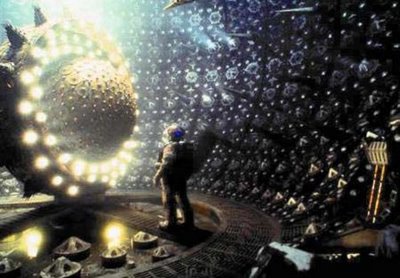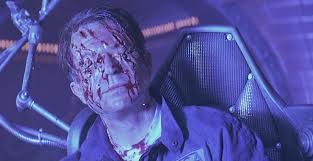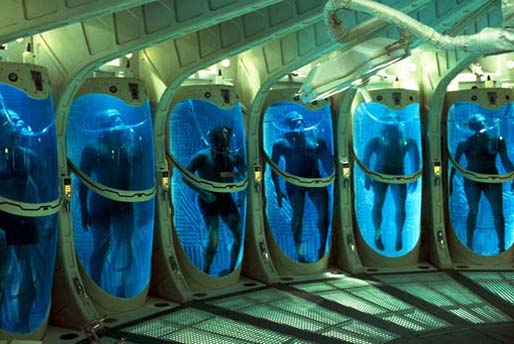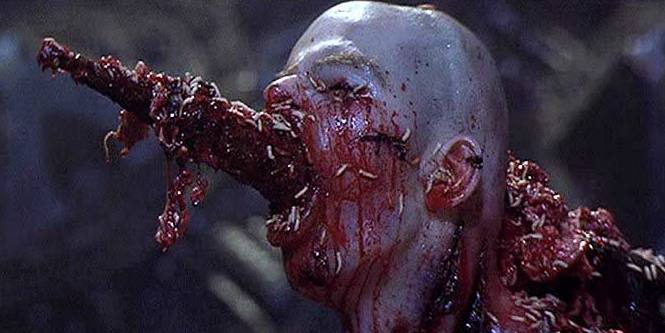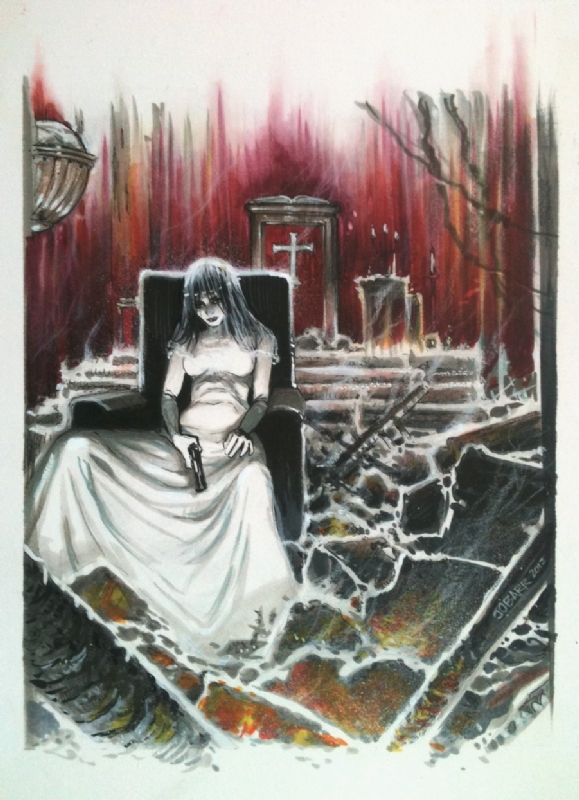
The cover to issue #1 of THE CROW: THE ENGINES OF DESPAIR, a six-part comics series which marks James O'Barr's return to his most famous creation. Used with permission.
At the Days of the Dead convention this weekend at the Sheraton Atlanta Hotel downtown, horror fans can meet and collect autographs from a rogues’ gallery of actors from a DEVIL’S REJECTS/HOUSE OF 1000 CORPSES cast reunions to Butch Patrick, the former child star who played Eddie Munster. Or they can visit the table of artist James O’Barr and pick up an exclusive signed print, preview original artwork from James’ first return to THE CROW in 20 years, and muse about art, favorite movies and the Retro glory days when Sophia Loren and Marilyn Monroe, full of curves and class, ruled the silver screen.
While quite a few comics creators delve into the darkness, James is one of a handful who cross mediums and regularly attends horror cons as often as comics gatherings. But that’s not the most surprising thing about him. First published by Caliber in the early 90s, then reprinted and completed by Tundra Publishing and recently picked up by IDW, The Crow’s revenge saga was inspired by James’ own tragic loss of a lover. It gained an even more mythic status among fans when Brandon Lee, son of Bruce Lee, died due to an accident on the set of the movie based on the comic. So as the creator of a vigilante antihero with an androgynous mimelike visage and Gothic black hair, James might be expected to be as tough as nails as his own hero Robert Mitchum or as dark and brooding as Trent Reznor. But anyone who’s met the artist knows that while he’s weathered his share of adversity amplified by years living in crime-ridden Detroit and dwells creatively in the realm of the dark phantastique, James has also come through the other side. He has emerged surprisingly soft-spoken and even with a signature joie de vivre. His most common public demeanor is a smile and a wisecrack, probably more than a little politically incorrect.
ATLRetro spent a couple of hours on the phone with James this week to find out more about what he’ll be doing and displaying at Days of the Dead, as well as what it’s like to be back drawing The Crow after all these years. And yeah, we couldn’t help but ask about his own influences from Will Eisner to Bernie Wrightson, mural painting with Mark Bode, his take on the BLADE RUNNER prequel, what makes Robert Mitchum still so unmatched among men, and find out his current Retro pin-up crush.
ATLRetro: You’re one of the few comics artists who regularly does horror media cons as well. What sets the comic and horror con experience apart for you?
James O’Barr: I am one of the fortunate ones that has a crossover audience since I had a film made of my comics. I don’t consider it a horror film, but it does get grouped in. There’s a lot of surface differences between the different crowds, but in reality they are kind of the same thing – groups of fans all broken up into little subgenres. At a comics show, some guys are just there for the super-heroes and others hate super-heroes. At a horror show, some people are into slasher movies. Other people hate them and love the classic Hammer Films. It’s the same animal but just from a different continent.
 Will you be have any new work or prints for sale at Days?
Will you be have any new work or prints for sale at Days?
Yeah, every time I do a show, I do a handful of prints, maybe 20 of each that you can only get from me and only at that show. That way the fans have something special that no one else has anywhere else in the US. I have so much material that it’s not difficult for me to pick a new image for each con.
Are you doing any panels or demonstrations at Days, or more body-painting like you did at the dooGallery during DragonCon?
I don’t think I have anything officially scheduled. But the body-painting will be at the show, and I volunteered to paint some more half-naked girls because I had a lot of fun doing that last time. I’ve only done it three times, and it’s a learning process. I’m getting better each time. Body-painting is difficult because it’s like painting with makeup, and it has entirely different textures than paint or ink, plus you’re not dealing with a flat surface. It does make a difference because I when I painted Frankenstein or Dracula on a girl’s back the last time I was there, I had to take into account the arch of her back so it didn’t look like he didn’t have a chin. It’s like Michelangelo at the Sistine Chapel where he had to elongate the figures so they would look correct from the floor.
What’s the craziest thing a fan ever did to get your attention at a con?
Just the typical like a woman showing me their tits and people just trying to shock me. I’m not easily shocked. Mostly my fans are very kind and gracious and very polite. I have the greatest fans in world who have stuck with me for 25 years, and because of them, I get to do what I love for a living. So I’m very appreciative.
 You’ve said that you wanted to work with Jim Terry (the artist on THE CROW:SKINNING THE WOLVES, the recently released three-issue IDW miniseries set in a Nazi concentration camp) because you liked his “Eisneresque style.” How much of an influence was Will Eisner on your own work and wanting to get into comics?
You’ve said that you wanted to work with Jim Terry (the artist on THE CROW:SKINNING THE WOLVES, the recently released three-issue IDW miniseries set in a Nazi concentration camp) because you liked his “Eisneresque style.” How much of an influence was Will Eisner on your own work and wanting to get into comics?
Will Eisner was a huge influence on me. It was by studying old SPIRIT stories that I learned actual storytelling. Then it suddenly dawned on me that he was taking film techniques and applying them to comics, and no one had ever done that before. So I pretty much took that basic premise, using film techniques in comics for lighting set-ups and camera angles, and I push that as far as I can into comics. As much as movies and comics have in common with each other, they also have so much uncommon or ‘discommon’ between them as well. In comics, you can’t control the timing like you can in a film, but you can slow down the pace of a page by making someone spend more time by putting more images on it. Another huge drawback is lack of sound. You don’t have a soundtrack to accentuate the emotions portrayed in the image. You don’t have the voices of the actors, and you don’t have sound effects, so you have to rely on the reader to supply those in their head. But like I said, it can also be a plus. What’s there is only what you put there, but an actor could spoil a scene or music could spoil a scene or a bad sound effect could spoil a scene. I am one of the few artists who does employ sound effects. If someone fires a gun in my comic, there’s a big boom sound effect. To me, supplying sound effects is an essential part of comics. It’s one of the charms of comics, I think.
If you had to pick five classic comics artist greats to recommend to a new reader, who would they be?
Will Eisner. Harvey Kurtzman. Jordi Bernet is not well-known in the US. He’s from old Milton Caniff (TERRY AND THE PIRATES, STEVE CANYON) school – lot of brushwork and shadows. IDW is reprinting his TORPEDO series about gangsters in the 1930s. There are so many. Bernie Wrightson was a huge influence on me. The way I look at it, Will Eisner showed me how to tell the story, but Berni Wrightson showed me how to light the scene for the most dramatic effect. And probably Dave Sim for teaching me how to include dialogue and sound effects into the artwork to where they are essential, which is why I like Dave Sim.
I still hand-letter all of my comics on the actual artwork. Since we’re talking Retro, I might as well point out I don’t use computers for anything. Everything is ink on papr or paint on paper. Nothing is photoshopped. Even my titles are hand-drawn on artwork – which is a pain because lettering is not my forte. I can do balloons, but with a three-inch font, I inevitably fuck it up. But that’s part of charm of hand-lettering. It’s not a perfect font pulled off a computer. It’s not that I have disregard for PhotoShop and those tools. I see people like Jon Foster who do great artwork with them Looking at his work, I couldn’t tell it wasn’t oil-painted or acrylics, but to me, using a mouse or a keyboard or a tablet would just drain all the fun out of comics. I love draging a brush across a blank page. For me, that’s the joy of creating comics. I sit down with a blank sheet of paper, and everything is my choice. And it has to be the right choice because there is no undo. This may make me a more confident artist than those who use computers. I don’t redo. I know what I want before I sit down.
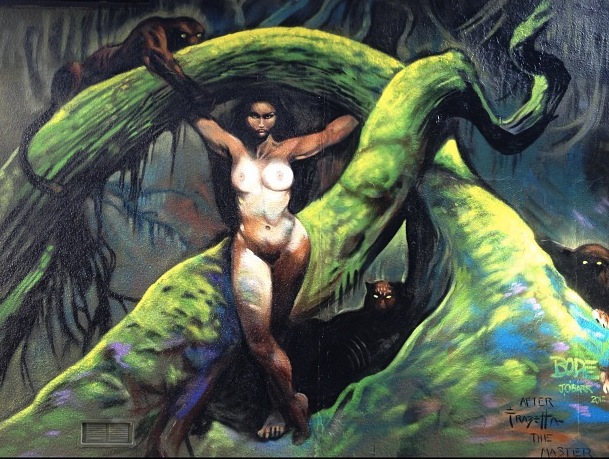
Mark Bode's and James O'Barr's mural tribute to Frank Frazetta at Clarion Alley in San Francisco.
Do you have any more mural work planned with Mark Bode, and how does working with a spray can on a wall compare to a paintbrush on a canvas?
Every time I see Mark, usually once or twice a year, we plan on doing something. The only difficult thing is San Francisco is finding a place to do it and deciding what we’re going to do. But the four we have done have gotten progressively better. I posted some pictures of the Frank Frazetta one on the Internet, and people thought it was the original, so we’ve gotten really good at it. They all have been tributes to our artistic heroes who have passed away – Moebius, Jeff Jones and Frazetta. I’m going to be up there later this year, and we’re hoping to do a Jack Kirby one which will be a lot of fun — to do that hyper-stylized Kirby line. The main difficulty is not necessarily working with a spray can but it’s working that large. The shortest was like 20 feet tall, so it involves being up on a ladder and drawing, and it’s hard to tell if something is in proportion without stepping back off ladder and walkg back 20 feet. Mark and I are really good about trading off with one of us painting and the other watching. He taught me everything I know about graffiti art, even though I still do more artistic things rather than scribbles or tags. I have no idea what they say. I would rather do Monet’s waterlilies 20 feet tall than put a line of poetry up there that is so stylized that the lettering is illegible. I like mural work. It’s free, outside and for the public. It’s transient because it will only be there for a certain amount of time. And it’s been great to introduce certain artists, like Jeff Jones, to people who may not have ever heard of them before.
What has the reaction been to the return of THE CROW published by IDW?
Honestly it’s been mixed. The one I’m doing by myself (THE CROW: THE ENGINES OF DESPAIR) hasn’t come out yet, but I think some people were expecting right off the bat that the first book would be mine. The first series looks very rushed, though it had a nice script by John Shirley. THE CROW: SKINNING THE WOLVES book has done phenomenally well. The first two issues sold out, and it’s in its second printing, and I think that’s because I was involved. It sticks rather closely to the kind of thing I do even though Jim Terry was responsible for the artwork.

From the original THE CROW series by James O'Barr.
THE CROW: THE ENGINES OF DESPAIR will be six issues. I’m finishing up the third issue, but I didn’t want them to solicit until the third was done because didn’t want there to be any lags between issues. I wanted them out on a regular basis because it’s continuing story. I have to say I am more than happy with the work I’ve done on it so far. It’s far and above the best thing I’ve ever done. I have definitely learned my craft over the last two decades. With the first CROW book, I honestly had no idea what I was doing. I just sat down and let things flow out of me. There are lots of flaws in that book, but I think the love and passion which I put into that work is what made the public love it and kept it in print for 25 years. But there were things in that book that I avoided because I didn’t have the skills to do them. With his book now, if I can think of it, I can draw it. It’s not a struggle at all. With every page, I set a challenge for me. How can I make it more difficult and learn something from this page. Without exception, 60-something pages into it, I’m delighted with every page.
Will it be in black and white like the original CROW or in color this time? And can you reveal anything about the story?
At the beginning, IDW kind of strong-armed me a little bit, saying they wanted it in color. I said it’s my project and it’s a CROW book, and I think it should be in black and white – or at least the ones I do should be. For me, it adds a certain otherworldly aspect to it with hard shadows. Honestly I don’t see it in the coloring I see in comics nowadays. If it was going to be in color, it would have to be handpainted by me, but I am hesitant to do that. However, that being said, I just did 20 black and white pages of this shootout and then in the middle, added an intermission in color – that kind of 1930s technicolor where everything is in brighter, warmer and hotter colors that don’t exist in real life. So that gives it a very dreamlike feel to it. Since I learned all the rules in the last 25 yrs, now I can break them.
Plus after 20 pages of people getting killed, it’s a nice little break for the reader as well. Still even though they are pretty and bright, happy colors, just them having been done by me has sort of a haunting creepy quality about it as well. Also I think it’s kind of funny that it’s a CROW book, but I am 60 pages into it and birds haven’t appeared in it once. I’m using rabbits this time. Not talking rabbits, but they are the animal in it. I think it’s so close in feel and atmosphere to the original book, all on a much higher level of competence, that people don’t even notice there’s not a bird in it. The bird will make a few cameo appearances.
It all looks really amazing, and in this one, the best character is the Skull Cowboy, that never actually appeared in the movie. The death character is with the woman the whole time. It kind of takes the place of the bird. The bunny man. He even scares me when I’m drawing him, probably because he reminds me a lot of myself. He’s very – I don’t want to say evil – but there are no ambidexterous morals in this. He’s frightening, but he’s a smart-ass and he’s lovable as well. It gives the bride a nice alter-ego to play off of.
I don’t want to give too much away, though. I’d rather that you come by the table [at Days of the Dead] and see what I’m doing and decide for yourselves. But I guarantee no one will be disappointed.
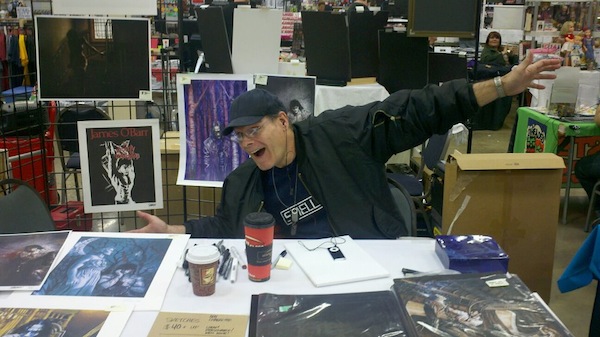
James O'Barr gets happy at his convention artist table. Photo courtesy of James O'Barr.
Shifting gears back to some of the pop culture you’re known for being passionate about, as a big BLADE RUNNER fan, how do you feel about Ridley Scott’s announcement that he’s going to go back to and do a prequel after all these years?
BLADE RUNNER was Ridley Scott’s vision so if he wants to go back and play in that universe, I am more than happy to sit in the audience. I will pay my $15. I really liked PROMETHEUS. I think I am one of the few people on the planet who did. I thought it did no disservice to the ALIEN film. I read somewhere he’s going to connect the ALIEN universe and the BLADE RUNNER universe or make references to both taking place at the same time. Somebody told me he read the script to PROMETHEUS 2 and that there were references to replicants in there. I’m a little skeptical about him pulling that off but I would love to see it. I have no idea what he is going to do, but I would love to see how the replicants got to Earth. He throws it all into one sentence — they escaped from an off-world colony. It would be great to see how Roy and Pris escaped from the planet where they were slave labor. I don’t know who could play those parts now, but it’s a really rich universe he created there and a lot was skimmed over the surface. I have a lot of faith in Ridley Scott. He’s made about 20 films and less than a handful have been bad. He needs to stay the fuck away from romantic comedies, though. The one he made with Russell Crowe and [Marion Cotillard] – A GOOD YEAR – that was just horrific, painful. He’s at his best when he’s exploring fantasy and science fiction and – some people probably will hate me but – nobody does epic like Ridley Scott. Even something like KINGDOM OF HEAVEN that’s factually based has more stunning imagery than all three LORD OF THE RINGS movies together.
 What’s so great about Robert Mitchum?
What’s so great about Robert Mitchum?
He was the last real man, I think. He was a brute and a gentleman and a real life badass. Jason Statham would last about 30 seconds with Robert Mitchum. He just has such a presence. He’s very subtle, and he never, ever plays to the camera. Laurence Olivier could not say a line without turning to the camera and making a face. Robert Mitchum wouldn’t care if his back was to the camera. He was so charismatic, and he was willingness to take on any role. That was endearing to me. He’d play the hero or the bad guy, he didn’t care. He was truly frightening in CAPE FEAR (1962). THE NIGHT OF THE HUNTER (1955) and OUT OF THE PAST (1947) are two films I could just watch any time. I do watch both of them once or twice a year. In fact, I just bought the British release poster for OUT OF THE PAST. It was called BUILD MY GALLOWS HIGH in London when it was released. That was the original name of the story.
You’ve often said that you admire the style and shape of the classic actresses and models of days gone by such as Sophia Loren, Marilyn Monroe and Bettie Page. Who’s your favorite right now and why?
Right now going through a mild Bettie Page fascination. I purposely avoided the whole Bettie Page parade 10 years ago because I was a little angered and disgusted that all these people were making money off this girl, my artists friends included. So I avoided anything Bettie Page. Just recently I subscribe to those vintage pinup Facebook pages, and I have gotten into appreciation. I see what it’s all about now – all the curves, and there was a really gentle innocence to her, too, where she always looks like she is having fun. I have definitely seen some pictures where I don’t think she had any idea what she was doing, such as the bondage stuff. That’s my least favorite. I love the images of her on the beach. There’s something about her eyes and her smile that is really endearing, and that silly haircut that people are still imitating today. I kind of group her in with Marilyn Monroe. I look at the pictures, and yes, I see all the right curves, but I don’t get aroused looking at them. It’s more endearing and charming to me than anything else. There’s something about both Bettie Page and Marilyn Monroe that makes me want to protect them. It makes me want to take on a fatherly role. I have never seen one so I assume it was impossible to take a bad picture of them. There’s some kind of inner beauty there which really transcends the film.
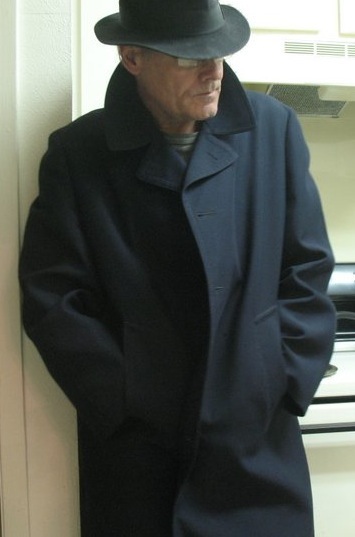
James O'Barr strikes a Mitchum pose. Photo courtesy of James O'Barr.
Given the success of THE CROW franchise, are a lot of fans surprised that you lead a pretty simple life of drawing/painting, writing, watching old movies and hanging out with cats?
The reality is that I grew up way below the poverty level, and so I have never been comfortable with luxury. It’s not that I don’t think I deserve it, but I don’t need it. Having expensive things does not make me happy. I’ve had a five-bedroom semi-mansion, and invariably I spent all my time in the basement in the dark drawing. There were rooms I never even went in. I like that I lead a very insular disciplined life, and I only bring things in that bring me joy and happiness—books and movies and music and artwork. I don’t need anything else. My cat’s my best friend. He never lies to me. He doesn’t cheat on me. He tries to lie to me. “You didn’t feed me. You didn’t feed me.” “Yes, I did. I did.” Just like dogs, they have unconditional love. My cat is lying on my feet right now. He wants to be close to me. I love dogs, too, but I prefer cats because they’re less needy. I can go away for a weekend, leave cat food, and he will be fine. I definitely like companionship. Being artist or a writer is very solitary. Just to have a little silent partner next to me is very comforting.
 LAWRENCE OF ARABIA (1962); Dir. David Lean; Starring Peter O’Toole, Omar Sharif, Alec Guinness, Anthony Quinn, Anthony Quayle, Claude Rains, Jack Hawkins; FIVE NIGHTS ONLY! Wed. Jan. 1 – Sun. Jan. 5 at 7:15 pm; Plaza Theatre; Trailer here.
LAWRENCE OF ARABIA (1962); Dir. David Lean; Starring Peter O’Toole, Omar Sharif, Alec Guinness, Anthony Quinn, Anthony Quayle, Claude Rains, Jack Hawkins; FIVE NIGHTS ONLY! Wed. Jan. 1 – Sun. Jan. 5 at 7:15 pm; Plaza Theatre; Trailer here.




